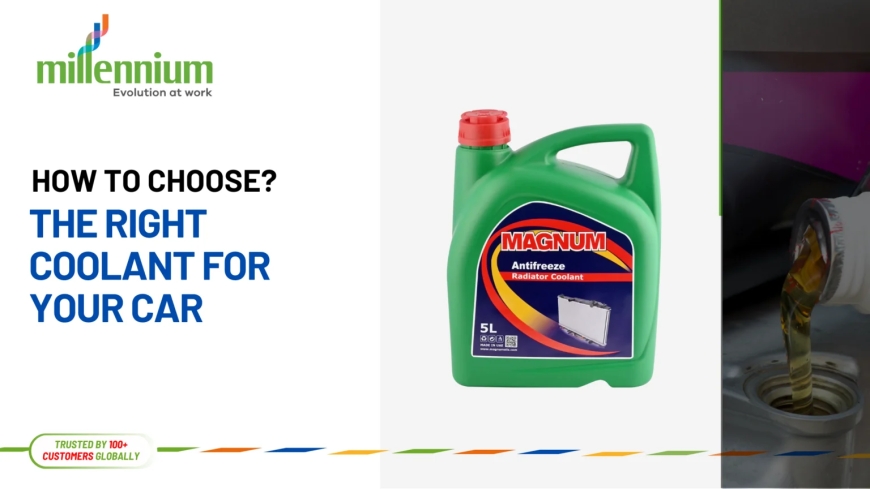How to Choose the Right Coolant for Your Car
Choosing the right coolant is essential for protecting your engine, maintaining performance, and extending the life of your vehicle.

What Exactly is Coolant, and Why is it Important in Your Car?
Coolant, often called antifreeze, is a vital liquid that circulates through your cars engine and radiator to maintain optimal operating temperatures. It plays a dual rolecooling the engine when it becomes too hot and protecting it from freezing in low temperatures. Coolant is typically made from a combination of water and chemical additives like ethylene glycol or propylene glycol, which enhance its thermal and anti-corrosive properties.
The importance of coolant goes far beyond just temperature control. It also prevents rust and scale buildup in the engine, lubricates the water pump, and raises the boiling point of the engines liquid to prevent overheating. Without the right coolant, your engine could overheat, freeze, or suffer from internal corrosionall of which can lead to costly repairs or even complete engine failure.
Signs You Need to Check or Change Your Coolant
Coolant doesnt last forever. Over time, it degrades, loses its protective qualities, and can even become contaminated. Here are some signs its time to check or replace your coolant:
-
High engine temperature gauge: If the temperature needle is consistently running hot, your coolant may be low or ineffective.
-
Coolant leaks: Puddles of green, orange, or pink fluid under your car indicate a possible leak.
-
Rust-colored or sludgy coolant: This indicates contamination, reducing the coolant's effectiveness and potentially damaging internal components.
-
Low coolant level in the reservoir: A noticeable drop in coolant level may mean you have a leak or the fluid is evaporating.
-
Sweet smell from the engine bay: Coolant has a sweet, syrupy smellif you detect it, there could be a leak.
Regular maintenance includes checking coolant levels and color, and replacing it according to your car manufacturers recommended intervals.
Step-by-Step Guide on How to Choose Coolant for Your Car
How to choose the right coolant for your car isnt as simple as picking any bottle off the shelf. Different cars require different types of coolant based on their engine design, metals used, and overall cooling system. Follow these steps to make the right choice:
1. Consult Your Owners Manual
Your car's manufacturer will specify the exact type of coolant that should be used. This includes the base (ethylene glycol or propylene glycol), the additive technology (IAT, OAT, HOAT, etc.), and even the color in some cases. Always use whats recommended.
2. Understand the Types of Coolant
There are three main types of coolant based on additive technology:
-
IAT (Inorganic Additive Technology): Typically green, used in older vehicles. Needs replacement every 2 years or 30,000 miles.
-
OAT (Organic Acid Technology): Usually orange, red, or pink. Found in newer models, offering longer life (up to 150,000 miles or 5 years).
-
HOAT (Hybrid Organic Acid Technology): A blend of IAT and OAT, often yellow or turquoise. Found in many European and American vehicles.
Using the wrong type can cause chemical reactions, reduce cooling efficiency, or damage engine components.
3. Choose Based on Driving Conditions
-
Extreme climates: If you live in very hot or cold areas, ensure the coolant has a wide operating range.
-
Heavy-duty usage: For trucks or cars used in towing, high-performance, or long-distance travel, use coolant with extended life and enhanced corrosion protection.
-
Environmentally friendly option: If toxicity is a concern (e.g., for pets or accidental spills), choose a propylene glycol-based coolant, which is less harmful than ethylene glycol.
4. Never Mix Coolant Types
Mixing two different types of coolant can reduce effectiveness and form sludge or gel-like substances. Always flush the system completely before switching to a new type of coolant.
5. Check for Pre-Mixed or Concentrate
Coolants are available in two forms:
-
Pre-mixed (50/50): Ready to use, with a 50% water and 50% coolant ratio.
-
Concentrate: Needs to be diluted before use. Usually mixed with distilled water at the correct ratio (commonly 50/50).
Using tap water to mix concentrate is not recommended, as minerals in the water can cause scaling inside the cooling system.
6. Consider Brand and Certification
Use reputable brands that meet industry standards (like ASTM D3306 or OEM-specific certifications). Well-known brands tend to offer better quality control and reliability.
Conclusion: How to Choose Antifreeze or Coolant for Your Car
Choosing the right coolant is essential for protecting your engine, maintaining performance, and extending the life of your vehicle. Begin by understanding your cars specific needs from the owners manual, identify the right coolant type and formulation, and avoid mixing incompatible fluids. Whether youre topping off or doing a complete flush, always use high-quality, compatible products.
In the long run, selecting the correct antifreeze or coolant ensures that your car runs smoothly in all weather conditions, saves you from costly repairs, and contributes to the overall health of your engine. Dont leave it to guessworkmake an informed choice every time.









































